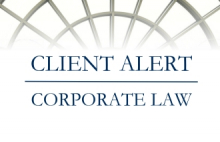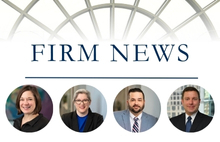National Bank Powers for Federal Thrifts under Proposed OCC Rule
September 2018The Office of the Comptroller of the Currency (OCC) has proposed a new rule that would provide most federal savings associations with the opportunity to elect national bank powers. According to the OCC, the new rule would enable federal savings associations to adapt to economic conditions and business environments without the cost and time needed to convert charters.
Effect of “Covered Savings Association” Status
New section 5A of the Home Owners’ Loan Act (HOLA), added by the Economic Growth, Regulatory Relief, and Consumer Protection Act (EGRRCPA), allows a federal thrift with assets of $20 billion or less as of December 31, 2017 to elect to operate as a “covered savings association.” A covered savings association will have the same rights and privileges, and will be subject to the same obligations and liabilities, as a national bank with its main office in the same location as the home office of the covered savings association.
A federal thrift that makes the covered savings association election will be freed from regulatory requirements to focus on home and consumer lending instead of commercial lending. For example, a covered savings association would not be subject to the qualified thrift lender (QTL) test contained in HOLA. According to the OCC, a covered savings association would not be able to exercise the rights and privileges conferred on it under section 5A (and have the activities and asset mix permitted to a national bank) while being subject to the QTL test. The OCC applies a similar analysis to the limits on aggregate amounts of loans secured by liens on nonresidential real property, additional restrictions on loans to a single borrower, other borrowing limitations, and certain affiliate transaction requirements. Because national banks are not subject to the restrictions described in these provisions (and the proposed rule does not require covered savings associations to continue to comply with these provisions), covered savings associations would not be subject to these provisions.
The OCC proposed two alternatives to clarify what it means for a covered savings association to have the rights and privileges, and the same duties and limitations, of a similarly located national bank. The first alternative focuses on applicable laws and requires covered savings associations to comply with the same laws that would apply to similarly located national banks and would not require the association to comply with the provisions that apply to federal thrifts, except in areas specified in the OCC rule, such as governance, business combinations, conversions (including mutual to stock conversions), and conservatorship and receivership. The second alternative focuses on activities and generally allows covered savings associations to engage in any activities permitted for similarly located national banks either as part of or incidental to the business of banking or as explicitly authorized by statute. The second alternative would be subject to the same exception as in the first alternative for provisions that would remain applicable to federal savings associations. The OCC invited comment on which alternative would better clarify the requirements for the treatment of covered savings associations.
The EGRRCPA and the OCC expressly state that covered savings association status does not confer rights or privileges that would not be available to similarly located national banks, unless otherwise required by HOLA section 5A or the proposed rule. Covered savings associations would be required to divest, conform, or discontinue nonconforming subsidiaries, assets, and activities over specified time periods.
Covered Savings Association Election
To operate as a covered savings association under the proposed rule, a federal thrift would need to submit a notice to its regional OCC office. The federal thrift would be deemed approved to operate as a covered savings association automatically 60 days after the OCC receives the notice, unless the OCC were to convey that the association is not eligible. (The OCC may also approve covered savings association status prior to expiration of the 60-day period.) An “eligible savings association” is a federal thrift that
- is well capitalized;
- has a composite CAMELS (Capital adequacy, Asset quality, Management, Earnings, and Liquidity) rating of 1 or 2;
- has a Community Reinvestment Act rating of “outstanding” or “satisfactory";
- has a consumer compliance rating of 1 or 2; and
- is not subject to an enforcement action, or if subject to any such action, is informed by the OCC that it may nevertheless be treated as an “eligible savings association.”
Date Limitations on Election Eligibility
The proposed rule makes any depository institution that was not a federal savings association as of December 31, 2017 ineligible for covered savings association status. As a result, entities that convert to a federal thrift charter after December 31, 2017, such as state savings associations, state savings banks, or credit unions, would not be eligible to elect covered savings association status. Similarly, a de novo federal thrift chartered after December 31, 2017 would not be eligible. The OCC invited comment on this aspect of the proposed rule.
Termination and Reelection
A covered savings association may terminate its election and return to operation as a federal savings association that has not made an election. Additionally, a federal savings association that has terminated its election to operate as a covered savings association may reelect to operate as a covered savings association after five years, unless the OCC approves an earlier reelection. The procedures for reelection are the same as for a first-time election.
Comments on the proposed rule are due November 19, 2018.
If you have any questions about the proposed rule, please contact one of our Banking & Financial attorneys.








